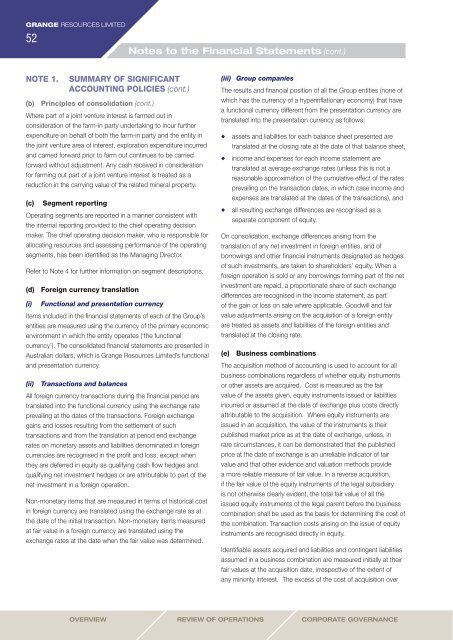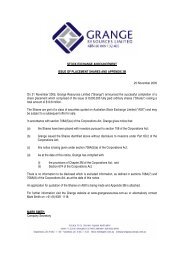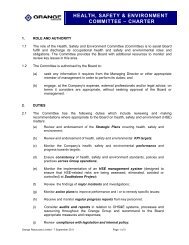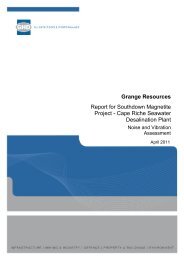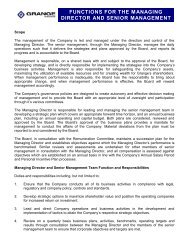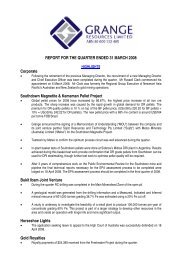2011 Annual Report (3 April 2012) - Grange Resources
2011 Annual Report (3 April 2012) - Grange Resources
2011 Annual Report (3 April 2012) - Grange Resources
Create successful ePaper yourself
Turn your PDF publications into a flip-book with our unique Google optimized e-Paper software.
GRANGE RESOURCES LIMITED<br />
52<br />
Notes to the Financial Statements (cont.)<br />
NOTE 1.<br />
SUMMARY OF SIGNIFICANT<br />
aCCOUNTING POLICIES (cont.)<br />
(b) Principles of consolidation (cont.)<br />
Where part of a joint venture interest is farmed out in<br />
consideration of the farm-in party undertaking to incur further<br />
expenditure on behalf of both the farm-in party and the entity in<br />
the joint venture area of interest, exploration expenditure incurred<br />
and carried forward prior to farm out continues to be carried<br />
forward without adjustment. Any cash received in consideration<br />
for farming out part of a joint venture interest is treated as a<br />
reduction in the carrying value of the related mineral property.<br />
(c) Segment reporting<br />
Operating segments are reported in a manner consistent with<br />
the internal reporting provided to the chief operating decision<br />
maker. The chief operating decision maker, who is responsible for<br />
allocating resources and assessing performance of the operating<br />
segments, has been identified as the Managing Director.<br />
Refer to Note 4 for further information on segment descriptions.<br />
(d) Foreign currency translation<br />
(i) Functional and presentation currency<br />
Items included in the financial statements of each of the Group’s<br />
entities are measured using the currency of the primary economic<br />
environment in which the entity operates (‘the functional<br />
currency’). The consolidated financial statements are presented in<br />
Australian dollars, which is <strong>Grange</strong> <strong>Resources</strong> Limited’s functional<br />
and presentation currency.<br />
(ii) Transactions and balances<br />
All foreign currency transactions during the financial period are<br />
translated into the functional currency using the exchange rate<br />
prevailing at the dates of the transactions. Foreign exchange<br />
gains and losses resulting from the settlement of such<br />
transactions and from the translation at period end exchange<br />
rates on monetary assets and liabilities denominated in foreign<br />
currencies are recognised in the profit and loss, except when<br />
they are deferred in equity as qualifying cash flow hedges and<br />
qualifying net investment hedges or are attributable to part of the<br />
net investment in a foreign operation.<br />
Non-monetary items that are measured in terms of historical cost<br />
in foreign currency are translated using the exchange rate as at<br />
the date of the initial transaction. Non-monetary items measured<br />
at fair value in a foreign currency are translated using the<br />
exchange rates at the date when the fair value was determined.<br />
(iii) Group companies<br />
The results and financial position of all the Group entities (none of<br />
which has the currency of a hyperinflationary economy) that have<br />
a functional currency different from the presentation currency are<br />
translated into the presentation currency as follows:<br />
◆◆<br />
◆◆<br />
assets and liabilities for each balance sheet presented are<br />
translated at the closing rate at the date of that balance sheet,<br />
income and expenses for each income statement are<br />
translated at average exchange rates (unless this is not a<br />
reasonable approximation of the cumulative effect of the rates<br />
prevailing on the transaction dates, in which case income and<br />
expenses are translated at the dates of the transactions), and<br />
◆ ◆ all resulting exchange differences are recognised as a<br />
separate component of equity.<br />
On consolidation, exchange differences arising from the<br />
translation of any net investment in foreign entities, and of<br />
borrowings and other financial instruments designated as hedges<br />
of such investments, are taken to shareholders’ equity. When a<br />
foreign operation is sold or any borrowings forming part of the net<br />
investment are repaid, a proportionate share of such exchange<br />
differences are recognised in the income statement, as part<br />
of the gain or loss on sale where applicable. Goodwill and fair<br />
value adjustments arising on the acquisition of a foreign entity<br />
are treated as assets and liabilities of the foreign entities and<br />
translated at the closing rate.<br />
(e) Business combinations<br />
The acquisition method of accounting is used to account for all<br />
business combinations regardless of whether equity instruments<br />
or other assets are acquired. Cost is measured as the fair<br />
value of the assets given, equity instruments issued or liabilities<br />
incurred or assumed at the date of exchange plus costs directly<br />
attributable to the acquisition. Where equity instruments are<br />
issued in an acquisition, the value of the instruments is their<br />
published market price as at the date of exchange, unless, in<br />
rare circumstances, it can be demonstrated that the published<br />
price at the date of exchange is an unreliable indicator of fair<br />
value and that other evidence and valuation methods provide<br />
a more reliable measure of fair value. In a reverse acquisition,<br />
if the fair value of the equity instruments of the legal subsidiary<br />
is not otherwise clearly evident, the total fair value of all the<br />
issued equity instruments of the legal parent before the business<br />
combination shall be used as the basis for determining the cost of<br />
the combination. Transaction costs arising on the issue of equity<br />
instruments are recognised directly in equity.<br />
Identifiable assets acquired and liabilities and contingent liabilities<br />
assumed in a business combination are measured initially at their<br />
fair values at the acquisition date, irrespective of the extent of<br />
any minority interest. The excess of the cost of acquisition over<br />
Overview Review Of Operations Corporate Governance


